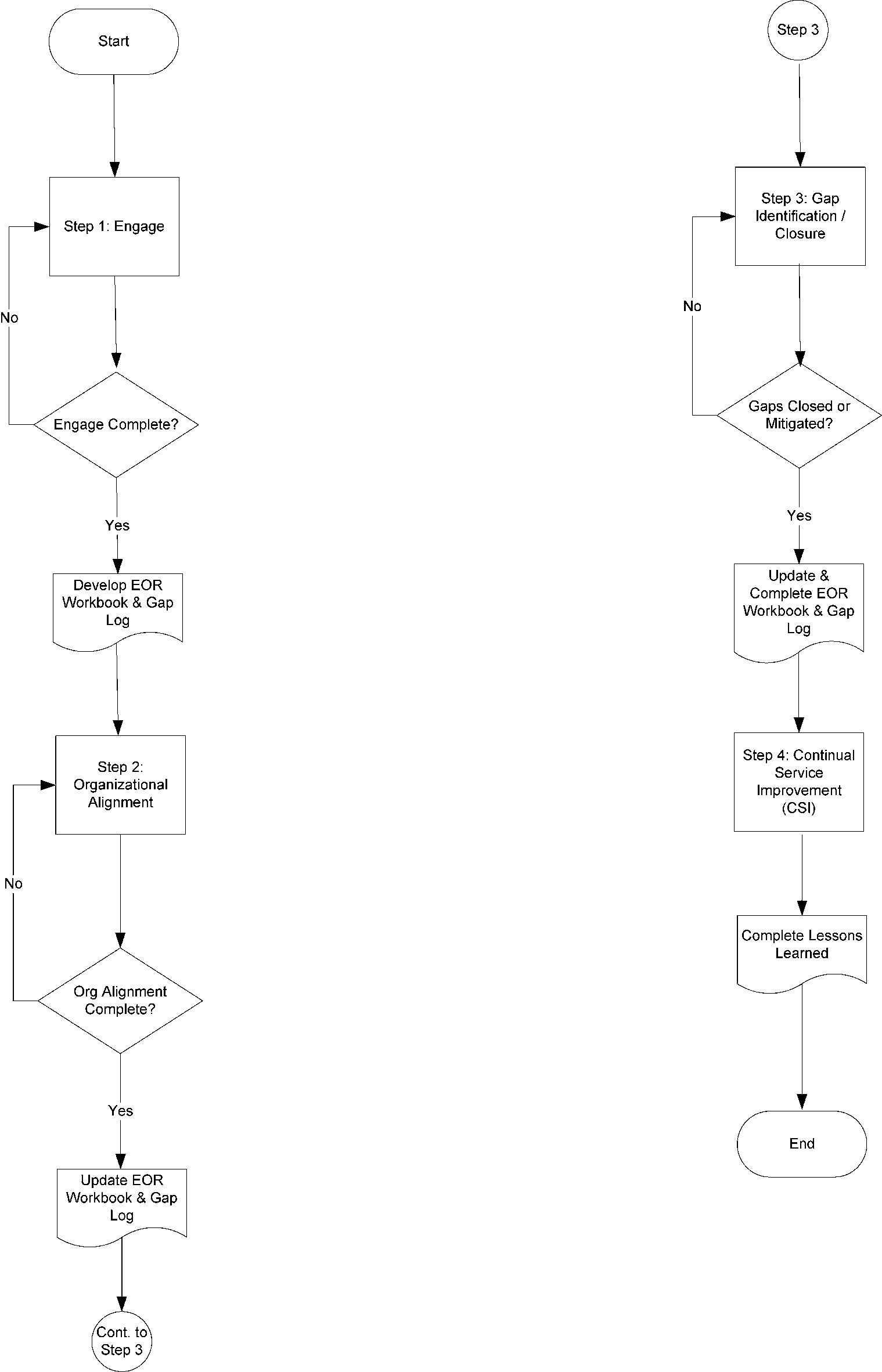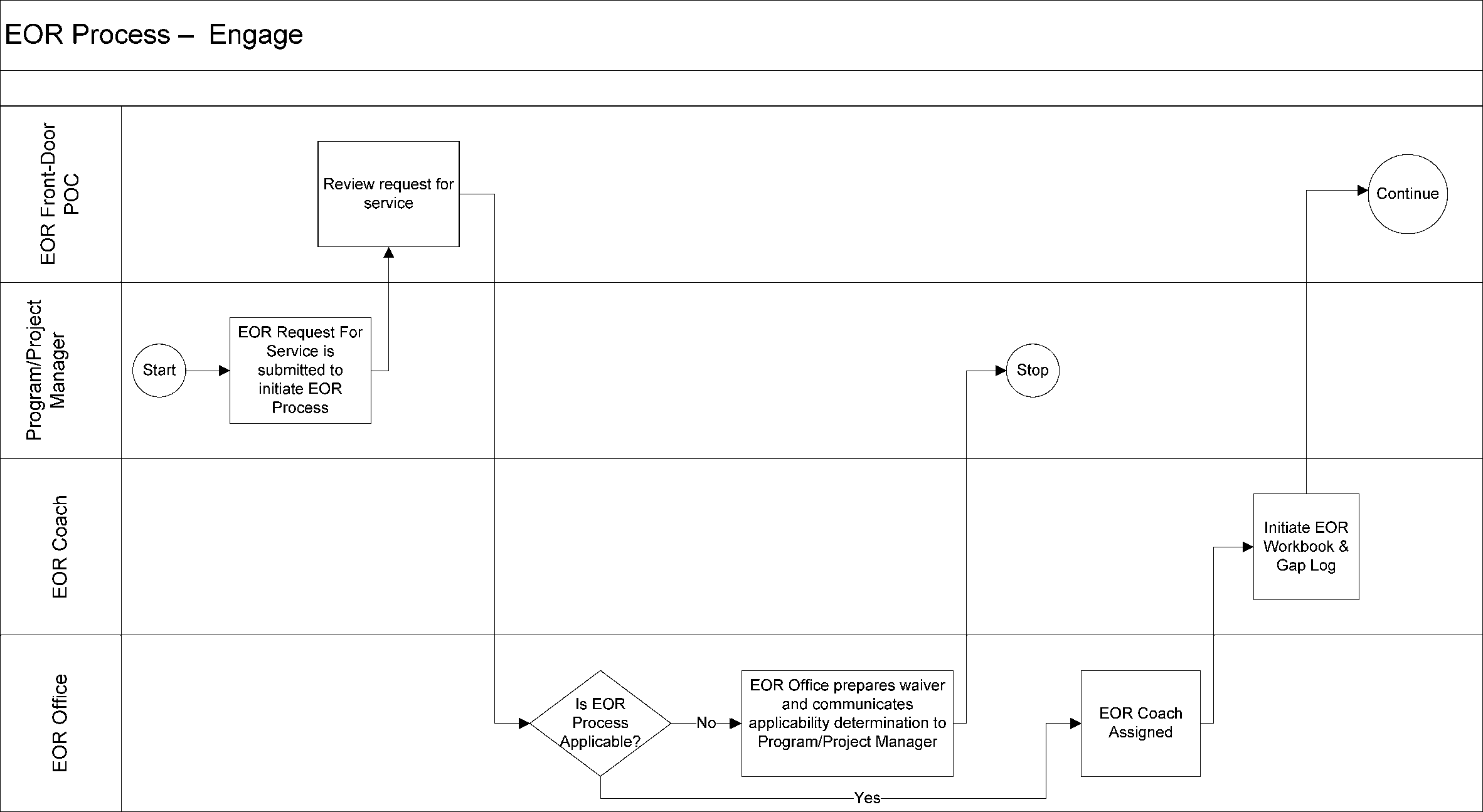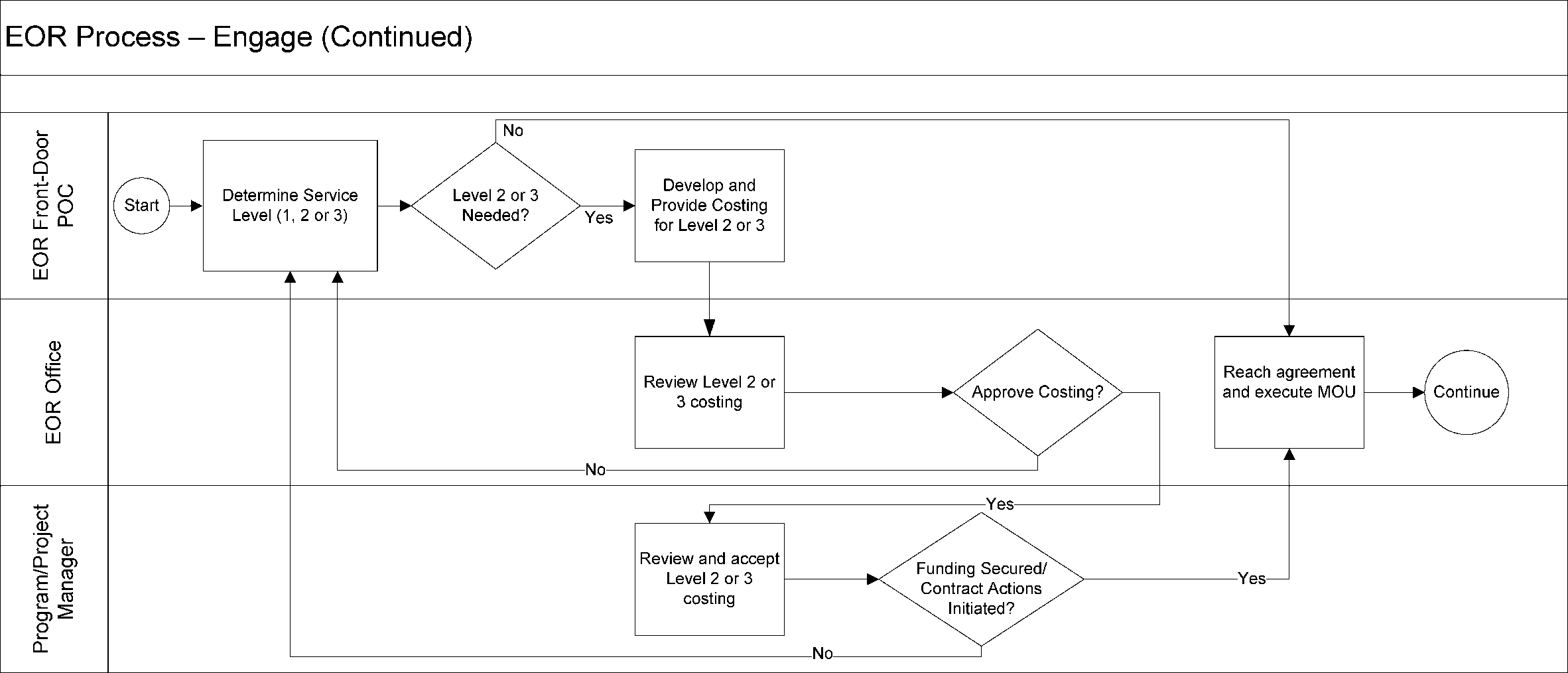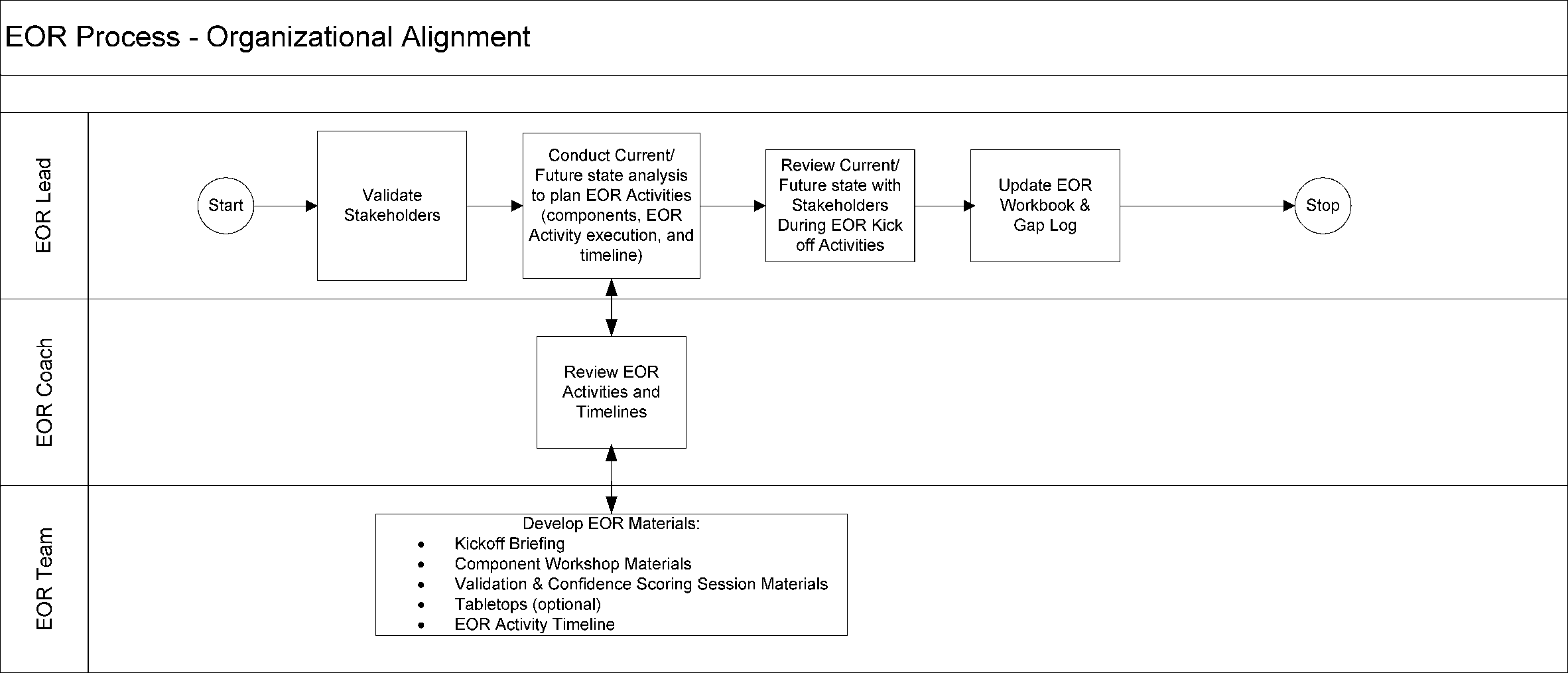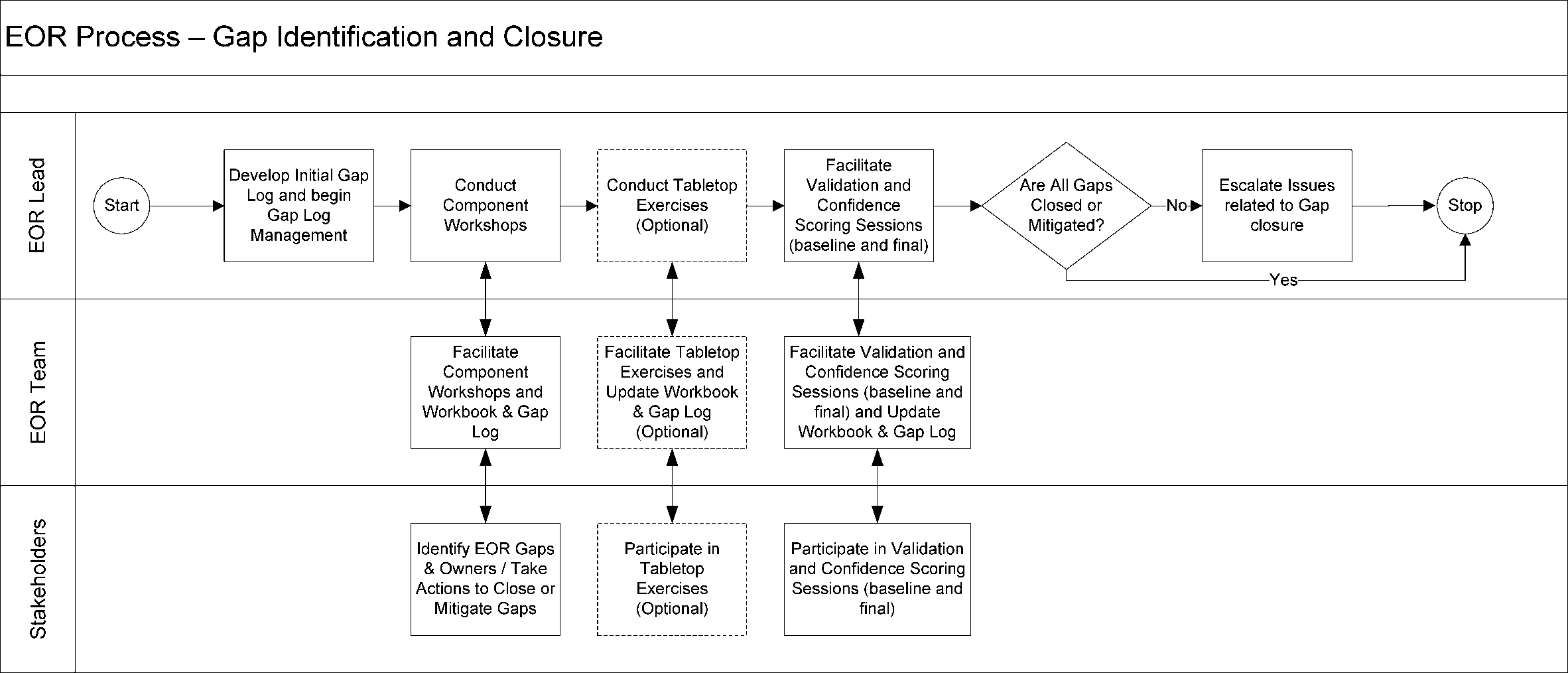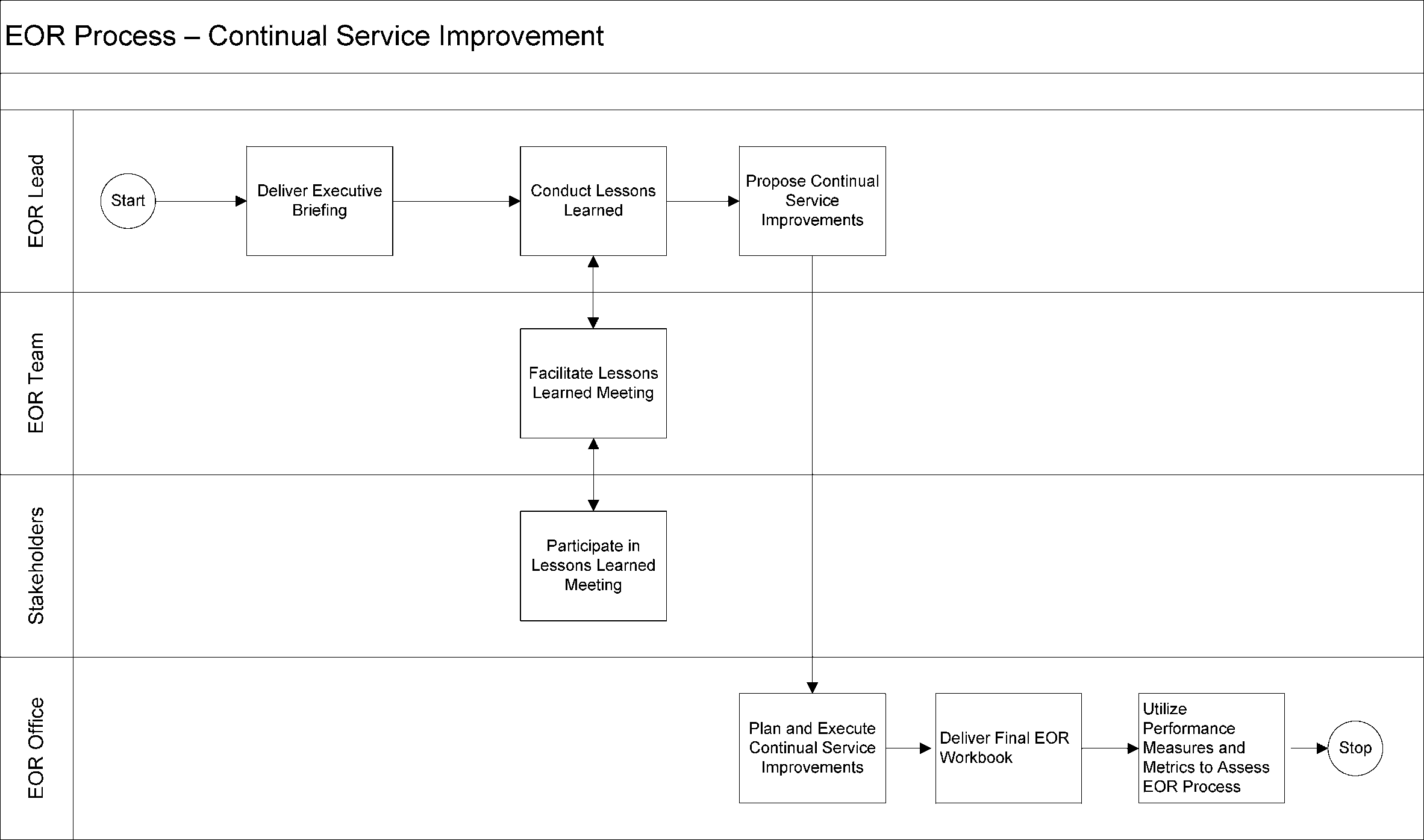- 2.126.2 Enterprise Organizational Readiness (EOR) Process and Procedure
- 2.126.2.1 Program Scope and Objectives
- 2.126.2.1.1 Background
- 2.126.2.1.2 Authority
- 2.126.2.1.3 Roles and Responsibilities
- 2.126.2.1.4 Program Management and Review
- 2.126.2.1.5 Program Controls
- 2.126.2.1.5.1 Process Controls
- 2.126.2.1.5.2 Metrics
- 2.126.2.1.5.3 Tailoring Guidelines
- 2.126.2.1.6 Terms/Acronyms
- 2.126.2.1.7 Related Resources
- 2.126.2.2 Process Workflow
- 2.126.2.2.1 Main Process Diagram
- 2.126.2.2.2 Inputs
- 2.126.2.2.3 Outputs
- 2.126.2.2.4 Activities
- 2.126.2.2.5 Procedure
- 2.126.2.2.5.1 Engage
- 2.126.2.2.5.2 Organizational Alignment
- 2.126.2.2.5.3 Gap Identification and Closure
- 2.126.2.2.5.4 Continual Service Improvement
- 2.126.2.1 Program Scope and Objectives
Part 2. Information Technology
Chapter 126. Transition Management
Section 2. Enterprise Organizational Readiness (EOR) Process and Procedure
2.126.2 Enterprise Organizational Readiness (EOR) Process and Procedure
Manual Transmittal
November 03, 2023
Purpose
(1) This transmits revised IRM 2.126.2 to reflect updates to the Enterprise Organizational Readiness (EOR) Process and Procedure.
Material Changes
(1) Changes are as follows:
-
Updated format to align with the most recent version of the Internal Controls Template located on the Internal Management Documents Community Web Page.
-
Moved information contained within Section 2.126.2.1 (Program Scope and Objectives) to Section 2.126.2.1.1 (Background).
-
Moved Section 2.126.2.4 (Program Management and Review) to Section 2.126.2.1.4 (Program Management and Review). New section was changed to define “Program Reports” and “Program Effectiveness.”
-
Moved Section 2.126.2.5 (Program Control) to Section 2.126.2.1.5 (Program Controls) and included a paragraph describing the EOR Guide.
-
The material relating to “Mandate” previously contained in Section 2.126.1.1 of IRM 2.126.1 is incorporated into Section 2.126.2.1.6, “Terms/Acronyms" of this IRM.
Effect on Other Documents
IRM 2.126.2, dated November 22, 2019, is superceded.
Audience
The provisions in this manual apply to all IRS Organizations.Effective Date
(11-03-2023)
Kaschit Pandya
Acting, Chief Information Officer
-
Overview: Describes the formal Information Technology (IT) policy for implementing the requirements of the Enterprise Organizational Readiness (EOR) Process.
-
Purpose: Provides guidance on how to use the EOR Process throughout the Enterprise Life Cycle (ELC) of the IRS.
-
Audience: Enterprise-wide.
-
Policy Owner: Director, Enterprise Program Controls Office.
-
Program Owner: Senior Manager, Enterprise Organizational Readiness (EOR) Office.
-
Primary Stakeholders: Information Technology, (IT), Business Operating Divisions (BODs), Functional Operating Divisions (FODs), and external stakeholder organizations as applicable.
-
Program Goals: Ensure stakeholders are ready to perform pre-deployment, deployment and post-deployment roles and responsibilities for delivery, ownership, use, operations and maintenance.
-
The EOR Office is the IRS ELC owner for all EOR activities. The EOR Office defines the scope of the EOR Process as it applies to Information Technology (IT), Business Operating Divisions (BODs), Functional Operating Divisions (FODs), and IT Delivery Partners. The EOR Office oversees all EOR activities and provides guidance, tools, training, and other support. Moreover, this office promotes the use of the EOR Guide in leading activities and adhering to best practices which position Programs/Projects for success throughout the entire life cycle.
-
This document describes the formal process and procedure for implementing the requirements of EOR. It provides an operational definition of the major components of the process and also describes the procedures that are essential to successfully complete the process and achieve desirable outcomes.
-
The EOR Process brings together stakeholders to ensure all are ready to perform their roles and responsibilities for delivery, ownership, use, operations, and maintenance.
-
The process consists of four phases which assist stakeholders in successfully managing change and to proactively identify gaps related to readiness. These phases are Engage, Organizational Alignment, Gap Identification and Closure, and Continuous Service Improvement.
-
Furthermore, each of the phases of the EOR Process consists of various activities that can be tailored to meet the specific needs of stakeholders.
-
The process definition laid out in this document further breaks down the Activities into Tasks, each of which have a complete set of attributes defined such as data and tool specifications, and the role(s) responsible for executing the tasks.
-
This includes identification and mitigation/closure of pre-deployment, deployment and post-deployment gaps in the readiness areas of People, Process, Technology and Financial
-
As the process owner, the EOR Office is responsible for the development, implementation, and maintenance of this IRM. Approval of this process and procedure, including updates, rests with the EOR Office. All proposed change requests must be submitted to the EOR Office.
-
Each process defines at least one role. Each role is assigned to perform specific tasks within the process. The responsibilities of a role are confined to the specific process. The role does not imply any functional standing within the hierarchy of an organization. For example, the process manager role does not imply the role is associated with or fulfilled by someone with functional management responsibilities within the organization. Within a specific process, there can be more than one individual associated with a specific role. Additionally, a single individual can assume more than one role within the process, although typically not at the same time.
Name Description EOR Coach Leads the readiness activities and provides guidance and direction using the EOR Process. EOR Front Door Point of Contact (POC) Introduces the EOR Process and is the initial contact between the EOR Office and the Program/Project to determine EOR applicability. EOR Lead Acts as a liaison between the EOR Office, the Program/Project and stakeholders. Responsible for Implementing the EOR activities with the EOR Process. EOR Office Serves as the IRS ELC Process Owner for all EOR activities, and provides guidance, tools, training, and other support. The EOR Office also reviews and approves completed EOR Workbooks and gap logs. EOR Team Tailors and executes the EOR activities as a collaborative group consisting of the EOR Lead and Stakeholder POC(s). Coordinates closure or mitigation of gaps in their organization. Executive(s) Provides executive oversight of the Program/Project. Provides POC(s) from their organization to support EOR activities. Program/Project Manager Provides insight and guidance on the Program/Project. Stakeholders Functions as primary contacts for impacted organizations; includes Business POC(s), IT Delivery Partners, external POC(s), etc., as required.
-
Program Reports: The EOR office maintains a SharePoint dashboard which is updated on a monthly basis by the EOR Coaches for each Program/Project. This data is used to assess trends in readiness gaps. Furthermore, the EOR office uses this tool to monitor Program/Project status and to track progress towards gap closure or mitigation.
-
Program Effectiveness: EOR Coaches facilitate a lessons learned session at the end of each Program/Project. This activity is a discussion with stakeholders on what went well, what did not go well, and possible improvements on the executed EOR activities. The objective is to complete a short survey which is used by the EOR office to identify process improvements for future EOR activities.
-
The EOR office has a dedicated process team who manage the content of a detailed guide used to inform and educate Program/Project stakeholders on the principles, strategies, and activities supporting successful deployments and transformations throughout the IRS Enterprise. The EOR Guide is the reference document for the EOR process and provides instruction on the development of the EOR Workbook and Gap Log deliverables. Furthermore, the process team also ensures the currency of all tools and templates used throughout the process.
-
Activities involved in ensuring a process is predictable, stable, and consistently operating at the target level of performance.
Process Management Statement The EOR Process will have a single Process Owner and a separate Process Manager, responsible for implementation and ensuring adherence to the process. The process will be reviewed regularly to ensure that it continues to support the business requirements of the enterprise. The process will be designed and developed based on return on investment (ROI) to the business. Process metrics will be focused on providing relevant information as opposed to merely presenting raw data. People Statement Roles and responsibilities for the process must be clearly defined and appropriately staffed with people having the required skills and training. The mission, goals, scope and importance of the process must be clearly and regularly communicated by upper management to the staff and business customers of IT. All staff (direct and indirect users of the process) shall be trained at the appropriate level to enable them to support the process. Rationale It is imperative that people working in, supporting, or interacting with the process in any manner understand what they are supposed to do. Without that understanding EOR will not be successful. Process Statement Modifications to the EOR Process must be approved by the Process Owner. The design to the process must include appropriate interfaces with other processes to facilitate data sharing, escalation, and workflow. The process must provide data to support real-time requirements as well as historical/trending data for overall process improvement initiatives. The process must be fully documented, published, and accessible to the various stakeholders of the process. The process will be reviewed on a periodic basis in order to ensure it continues to support organizational goals and objectives (continuous improvement). The process must include Inputs, Outputs, Controls, Metrics, Activities, Tasks, Roles and Responsibilities, Tool and Data requirements along with documented process flows. The process will be kept straight forward, rational, and easy to understand. Technology and Tools Statement All tools selected must conform to the enterprise architectural standards and direction. Existing in-house tools and technology will be used wherever possible, new tools will only be entertained if they satisfy a business need that cannot be met by current in-house tools. The selection of supporting tools must be process driven and based on the requirements of the business. Selected tools must provide ease of deployment, customization and use. Automated workflow, notification and escalation will be deployed wherever possible to minimize delays, ensure consistency, reduce manual intervention and ensure appropriate parties are made aware of issues requiring their attention. The tools used by this process are the following: -
EOR Workbook
-
EOR Gap Log
Rationale Technology and tools should be used to augment the process capabilities, not become an end themselves. -
-
Process controls represent the policies and guiding principles on how the process will operate. Controls provide direction over the operation of processes and define constraints or boundaries within which the process must operate.
Name Description Policies The EOR Office is responsible for the development, implementation, and maintenance of EOR Policy. EOR Policy approval, including updates, rests with the EOR Office. Scope All Programs/Projects following the ELC are required to engage the EOR Office prior to initiating Program/Project activities unless waived by the EOR Office.
-
Metrics are used for the quantitative and periodic assessment of a process. They should be associated with targets that are set based on specific business objectives. Metrics provide information related to the goals and objectives of a process and are used to take corrective action when desired results are not being achieved and can be used to drive continual improvement of process effectiveness and efficiency.
-
Management will regularly set targets for process performance, gather quantifiable data related to different functions of the EOR Process, and review that data for making informed decisions and taking appropriate corrective action, if necessary. All measurements will have a defined data dictionary, map to the organizational strategic goals, and be documented in a Process Measurement Plan.
-
The tailoring guidelines identify the allowable variations of the IT organization’s standard process as needed for adjustments (adding, deleting, modifying) relative to specific operational or functional needs of another organization. Process tailoring is about roles and procedures, not the standard process or major activities defined in this process. All tailoring requests, with supporting rationale, must be submitted in writing to and approved by the EOR Process owner.
-
EOR activities can be tailored to meet the specific needs of a Program/Project. As Information Technology embraces various ELC software development methods and delivery paths (Waterfall, Agile, etc.), EOR activities can be tailored to ensure readiness meets transformation needs while supporting multiple delivery paths. Moreover, the EOR process is scalable to support various technical and functional activities. The EOR Coach will support the assigned Program/Project with tailoring of the EOR Process to meet their specific needs.
-
The following table defines terms relevant to this program that are used throughout this IRM section:
Terms Definitions Component Workshop A forum with open dialogue where EOR Team members pose questions to stakeholders by Readiness Categories of People, Process, Technology and Financial to identify gaps by specific area of focus. Confidence Score A score for gaps provided during Validation and Confidence Scoring Sessions. This score reflects the organization’s confidence in its ability to complete necessary activities to close or mitigate open gaps. Continual Service Improvement (CSI) The CSI Phase of the EOR process is used to identify areas in the process that can be improved and areas that are working well based on stakeholder feedback. Current / Future State Analysis Analysis to outline current state and the future state of capabilities and functionality including roles and responsibilities. Enterprise Life Cycle (ELC) A framework used by IRS to move an IT solution from concept to production while ensuring compliance with IRS guidelines and compatibility with the overall goals of the IRS. Gap The variance between the current state and what is needed for the future state in the readiness categories of People, Process, Technology, and Financial. An open gap may translate into a risk if it remains unresolved. Level of Support There are three Levels of Support available which allows the EOR Office to effectively allocate time and resources to support the EOR activities. These include the following: -
Level 1 - Consult
-
Level 2 - Guide
-
Level 3 - Execute
Responsible, Accountable, Consulted, Informed (RACI) The RACI model is based on the principle that people act in one of four ways when executing a task. It accounts for the fact that more than one role may be active in performing a specific task while clearly defining specific responsibilities for that role. While many roles may be involved in a task only one is Accountable for the results. The actions are:
R - Responsible for the action (may do the task)
A - Accountable for the action (including approval)
C - Required to be Consulted on the action
I - Required to be Informed of the action. If a task does not have an Accountable role indicated, then the Responsible role is assumed to be accountable for the task.Tabletop Exercise A facilitated simulation or walkthrough designed to enable stakeholder participants to explore, validate and/or rehearse new or modified processes. Validation and Confidence Scoring Session A forum where the EOR Team provides stakeholders with the opportunity to validate and provide confidence scores based upon the Readiness Categories of People, Process, Technology, and Financial for each identified gap within a component. Request for EOR Service A form used to request EOR service which contains initial information about the Program/Project including Points of Contact (POCs) and proposed milestone exit dates. Additional information is solicited to assess EOR applicability. Moreover, the EOR service request form contains questions about which ELC Path will be followed (ex: Waterfall, Agile, etc.), staffing, training, documentation and business process to determine EOR impacts throughout the entire lifecycle. Memorandum of Understanding (MOU) The MOU is the agreement between the Program/Project and EOR office identifying the level of service to be provided. Once an EOR Coach is assigned, a MOU will be initiated by the Program/Project Office documenting the roles of the Program/Project Office and the EOR office based upon the level of service. Engage The initial phase with the objective of preparing and planning for the changes, and determining EOR service level support. Organizational Alignment The phase which ensures all stakeholders and their respective organizations are engaged and validated for participating in the EOR process. Analyzing the current and future state is a primary activity to ensure EOR activities address readiness. An initial approach on how EOR activities will be executed is presented during an EOR Kickoff meeting. Gap Identification and Closure This phase is comprised of activities to assess readiness for pre-deployment, deployment, and post-deployment within four readiness categories: People, Process, Technology, and Financial. Continual Service Improvement The phase which focuses on identifying EOR Process strengths and areas that need improvement to drive more efficient future outcomes for readiness. EOR Workbook The EOR Workbook summarizes and documents the EOR activities executed during the Engage, Organizational Alignment, Gap Identification and Closure, and Continual Service Improvement Phases. The EOR Workbook is a required ELC deliverable. Gap Log The EOR Gap Log is the authoritative document for recording all gaps and reflects the progress in closing or mitigating these gaps. Gaps identified at any point during the Program/Project life cycle are documented within the Gap Log, which is a key artifact of the EOR Workbook. Throughout the execution of EOR activities, the Program/Project team has the responsibility to identify an owner for each gap. The Gap Log is part of the EOR Workbook document but can be used independently and separately. Lessons Learned The EOR Lessons Learned documentation is essential, as it provides insight on the positive and/or negative experiences ascertained from the execution of EOR activities. The Program/Project Team facilitates a discussion with stakeholders to identify what went well and possible process improvements for future EOR activities. -
-
The following table defines acronyms frequently used throughout this IRM section:
Acronyms Definitions BOD Business Operating Division CSI Continual Service Improvement ELC Enterprise Life Cycle EOR Enterprise Organizational Readiness FOD Functional Operating Division IT Information Technology ITIL Information Technology Infrastructure Library MOU Memorandum of Understanding POC Point of Contact WBS Work Breakdown Structure
-
Additional guidance on the EOR Process can be found in the following:
-
EOR Guide.
-
-
Process training involves training all stakeholders about key processes that are crucial for an organization to deliver business objectives. Training provides clarity to employees on a set of procedures that needs to be carried out as part of the process and the best possible way to do them. Listed below are the training resources available for this process:
-
EOR Fundamentals Training provides a high level overview of EOR’s importance at the IRS, how it works, who plays a role, and assists attendees with achieving organizational readiness goals.
-
EOR Advanced Training provides a more detailed look at the EOR Process and how to implement it. Emphasis is provided on how to construct deliverables and opportunities for attendees to learn through practice exercises and simulations; there is no requirement to complete the Basic Training prior to attending the Advanced course.
-
-
A process workflow consists of Activities and Tasks, Inputs and Outputs, Roles, and Flow Diagrams. It describes the tasks, procedural steps, organizations or people involved, required input and output information, and tools needed for each step of the process.
-
Main Process Diagram
-
Process inputs are used as triggers to initiate the process and to produce the desired outputs. Users, stakeholders or other processes provide inputs. The following is a list of inputs for this process:
Name Description Supplier Request for EOR Service A form which contains initial information about the Program/Project including POCs and proposed milestone exit dates; it is used to request EOR service. The form solicits additional information to assess EOR applicability. Moreover, the EOR service request form contains questions about which ELC Path will be followed (ex: Waterfall, Agile, Iterative, etc.), staffing, training, documentation and business processes to determine EOR impacts throughout the entire lifecycle. Program/Project Manager Memorandum of Understanding (MOU) The MOU is the agreement between the Program/Project and EOR Office identifying the EOR level of service to be provided. Once an EOR Coach is assigned, an MOU will be initiated by the Program/Project Office documenting the roles of the Program/Project Office and the EOR Office based upon the level of service. Program/Project Manager and EOR Office
-
Each process produces tangible outputs. These outputs can take the form of products or data and can be delivered to a user or stakeholder, or they can be used as inputs to other processes. Outputs are measurable in terms of quantity and quality.
Name Description Supplier EOR Workbook The EOR Workbook documents the EOR activities executed during the Engage, Organizational Alignment, Gap Identification and Closure, and Continual Service Improvement phases. The EOR Workbook is a required ELC deliverable. Information contained within the EOR Workbook and Gap Log can further be used to develop Executive Reporting materials for leadership situational awareness and escalation of issues. EOR Office, EOR Team, Stakeholders EOR Gap Log The EOR Gap Log is the authoritative document for recording all gaps and reflects the progress in closing or mitigating gaps. Gaps identified at any point during the Program/Project life cycle are documented within the Gap Log, which is a key artifact of the EOR Workbook. Throughout the execution of EOR activities, Program/Project teams have the responsibility to identify an owner for each gap. The Gap log is part of the EOR Workbook document but can be used independently and separate from the EOR Workbook. EOR Office, EOR Team, Stakeholders Lessons Learned The EOR Lessons Learned documentation is essential, as it provides insight on the positive or negative experiences ascertained from executing the EOR Process. While conducting Lessons Learned activities, the EOR Team facilitates a discussion with stakeholders on what went well, what did not go well, and possible improvements to the EOR Process. EOR Office, EOR Team, Stakeholders
-
An activity is a major unit of work to be completed in achieving the objectives of the process. A process consists of a sequence of related activities that transforms inputs into outputs and performed by the roles defined in the process. Activities are measurable in terms of efficiency and effectiveness. Identify the activities in the process and provide a brief description. The activities must correspond with the high- level process flow diagram above.
ID Name Description 1.0 Engage Engage is the initial phase with the objective of preparing and planning for the changes. This phase includes the following activities -
Request EOR Service
-
Determine Service Level and Cost Estimate
-
Assign EOR Coach
-
Secure Funding
-
Execute MOU
-
Conduct Training
-
Develop WBS
-
Gain Executive Commitment
2.0 Organizational Alignment Organizational Alignment is the phase which ensures all stakeholders are engaged in analyzing the current and future state. This phase includes the following activities: -
Validate Stakeholders
-
Conduct Current/Future State Analysis
-
Conduct EOR Kickoff
3.0 Gap Identification and Closure Gap Identification and Closure is a phase comprised of the following activities to assess readiness within the People, Process, Technology, and Financial readiness categories. This phase includes the following activities: -
Conduct Component Workshops
-
Facilitate Validation and Confidence Scoring Sessions
-
Conduct Tabletop Exercises(s)
4.0 Continual Service Improvement (CSI) CSI is a phase which focuses on identifying EOR process strengths, and areas that need improvement. This phase includes the following activities: -
Conduct Lessons Learned
-
Deliver Executive Briefing
-
Utilize Performance Measures and Metrics
-
-
A procedure provides the step by step instructions, or tasks, in how to perform each activity in the process and usually applies to a single role that will be responsible in performing the task.
-
As depicted in the following RACI Model, the Engage phase initiates the EOR Process.
ID Task Name and Description Role RACI Duties EOR 1.1 Request EOR Service Program/Project Manager A 1.1 Submit completed service request form to the EOR Office. EOR 1.2 Review Request for EOR Service EOR Office R 1.2 Ensure EOR Service Requests are logged and appropriately categorized. Front-Door POC A EOR 1.3 Determine EOR Applicability Front-Door POC R 1.3 EOR Office assesses applicability of EOR Process based on the Program/Project’s required staffing, training, business processes, documentation changes, etc. EOR Office A Program/Project Manager C EOR
1.4 – 1.5Prepare EOR Waiver EOR Office A 1.4 EOR Office determines the EOR Process does not apply and prepares a waiver for the Program/Project.
1.5 Communicate EOR Applicability to Program/Project Manager.Program/Project Manager I EOR 1.6 Assign EOR Coach EOR Office A 1.6 Assign EOR Coach to the Program/Project. Program/Project Manager I EOR 1.7 Initiate EOR Workbook and Gap Log EOR Coach A 1.7 Prepare initial EOR Workbook and Gap Log for Program/Project. EOR
1.8 – 1.9Determine Service Level and Develop Cost Estimate Front-Door POC R 1.8 Discuss service level with Program/Project Manager.
1.9 Develop Level 2 or 3 Costing (as applicable).EOR Office A Program/Project Manager C EOR 1.10 Secure Funding Program/Project Manager A 1.10 Secure funding and initiate contracting actions if Level 2 or Level 3 support will be required. EOR Coach C EOR Office I EOR 1.11 Execute Memorandum of Understanding (MOU) Program/Project Manager R 1.11 Initiate a MOU to document the roles of the Program/Project Office and the EOR Office based upon the Level of Service to be provided. EOR Coach R EOR Office A EOR 1.12 Conduct Training EOR Coach R 1.12 Provide training to the Program/Project Manager, EOR Team, and stakeholders to understand the EOR process. Two classes are offered: Basic Training and Advanced Training. EOR Office A EOR 1.13 Develop EOR Work Breakdown Structure (WBS) Program/Project Manager R 1.13 Identify typical EOR activities and estimated timeframe to support completion of the EOR process. EOR Lead A EOR Coach C EOR
1.14 – 1.15Gain Executive Commitment Program/Project Manager R 1.14 Work with Executive leadership to gain commitment, alignment and support on the EOR activities to be executed.
1.15 Executive leadership provides a point-of-contact for their organization to the EOR Lead.EOR Lead A Executive(s) C EOR Coach C EOR Office I EOR 1.16 Update EOR Workbook and Gap Log EOR Team R 1.16 Ensure the EOR Workbook and Gap Log are updated as EOR activities are executed. EOR Lead A Stakeholders C EOR Coach I
-
Shown in the following RACI Model of the Organizational Alignment phase are the activities in which the EOR Team facilitates discussions with the Program/Project Manager to understand the objectives of the transformation, upcoming changes, and impacts to organizations. This phase includes ensuring all stakeholders are engaged in analyzing the organization’s current and future state as one of its primary activities.
ID Task Name and Description Role RACI Duties EOR 2.1 Validate Stakeholders EOR Team R 2.1 Identify Business, IT, and external stakeholders with a vested interest in the upcoming change. Program/Project Manager R EOR Lead A Stakeholders C EOR Coach I EOR 2.2 Conduct Current and Future State Analysis EOR Team R 2.2 Analyze the technical components of the current architecture, along with the future functionality and/or capabilities. EOR Lead A Stakeholders C EOR Coach I EOR 2.3 Conduct EOR Kickoff Meeting EOR Team R 2.3 Begin execution of the EOR activities and ensure stakeholders understand the desired future state, the scope of the change, and the approach to execute EOR activities. EOR Lead A Stakeholders C EOR Coach C EOR 2.4 Update EOR Workbook and Gap Log EOR Team R 2.4 Ensure the EOR Workbook and Gap Log are updated as EOR activities are executed. EOR Lead A Stakeholders C EOR Coach I
-
As shown in the following RACI table are the activities associated with the Gap Identification and Closure Phase. These iterative activities are intended to identify and close gaps that have been evaluated for their validity, criticality, and impacts to readiness.
ID Task Name and Description Role RACI Duties EOR
3.1 – 3.4Conduct Component Workshops EOR Team R 3.1 Tailor readiness discussion questions based upon the selected EOR Components.
3.2 Facilitate Component Workshop(s) to identify gaps.
3.3 Assess and report gaps.
3.4 Update the EOR Workbook.EOR Lead A Stakeholders C EOR Coach I EOR
3.5 – 3.8Facilitate Validation and Confidence Scoring Sessions EOR Team R 3.5 Re-validate gaps
3.6 Collect confidence scores from stakeholders.
3.7 Report confidence scores to key stakeholders and leadership.
3.8 Ensure the EOR Workbook and Gap Log are updated as EOR activities are executed.EOR Lead A Stakeholders C EOR Coach I EOR
3.9 – 3.12Conduct Tabletop Exercises (Optional) EOR Team R 3.9 Identify new or modified processes via stakeholder discussions.
3.10 Review Program/Project documentation and gather input from stakeholders.
3.11 Develop scenarios where stakeholders may be required to execute the new or modified processes.
3.12 Discuss scenarios during Tabletop Sessions to identify gaps.EOR Lead A Stakeholders C EOR Coach I
-
The following RACI Table depicts the activities related to the Continual Service Improvement (CSI) phase of the EOR process which is used to identify areas in the process that can be improved, and areas that are working well based on stakeholder feedback.
ID Task Name and Description Role RACI Duties EOR 4.1 Conduct Lessons Learned EOR Team R 4.1 Monitor and review EOR processes by gathering input from stakeholders. EOR Lead A Stakeholders C EOR Coach C EOR 4.2 Deliver Executive Briefing EOR Team R 4.2 Review progress and readiness of the Program/Project with Executives. EOR Lead A Program/Project Manager C EOR Coach C EOR 4.3 Deliver Final EOR Workbook EOR Lead R 4.3 Review and approve the completed EOR Workbook. EOR Office A Stakeholders C EOR 4.4 Utilize Performance Measures and Metrics EOR Office A 4.4 Execute a standardized method for monitoring the performance of EOR processes.

 )
hoặc https:// có nghĩa là bạn đã kết nối an toàn với trang web .gov. Chỉ chia sẻ thông tin nhạy cảm trên các trang web chính thức, an toàn.
)
hoặc https:// có nghĩa là bạn đã kết nối an toàn với trang web .gov. Chỉ chia sẻ thông tin nhạy cảm trên các trang web chính thức, an toàn.

